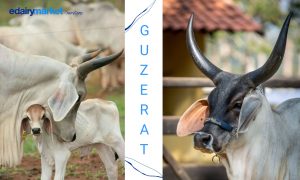
Today eDairy Market tells you about the evolution of dairy farming, which was accompanied by a collaborative effort involving many pioneers in different fields. Here are some of the key figures who contributed to the development of dairy farming.
1. Jesse Williams: In the early 19th century, Williams developed the first practical milking machine, which could be operated by hand.

2. Gustav de Laval: De Laval invented the first commercially successful mechanical milking machine in 1878, which was powered by a steam engine.

3. Louis Pasteur: Pasteur developed the pasteurization process in the 1860s, which involves heating milk to a high temperature to kill harmful bacteria.

4. Sir Alexander Fleming: Fleming discovered penicillin in 1928, which revolutionized the treatment of bacterial infections in dairy cattle.

5. Dr. Norman Borlaug: Borlaug was a plant breeder who developed high-yielding wheat varieties in the mid-20th century. These varieties provided a more abundant and affordable feed source for dairy cattle.

6. Temple Grandin: Grandin is an animal scientist who has made significant contributions to the field of animal welfare. Her work has helped improve the design of livestock handling facilities, including those used in the dairy industry.

7. Pioneers of organic and sustainable agriculture: There are many pioneers in the organic and sustainable agriculture movement, such as Albert Howard, J.I. Rodale and Wes Jackson. These individuals have advocated for more natural and environmentally friendly farming practices, including those used in the dairy industry.

These individuals, among many others, have played an important role in the evolution of dairy farming. Their contributions have helped improve milk production, animal welfare and the sustainability of the dairy industry.
The evolution of dairy farming has been a long and complex process. Here are some of the key milestones:
First domestication of cattle: cattle were domesticated around 8000-7000 B.C., and dairy farming likely began shortly thereafter. It is likely that early dairy farmers used primitive techniques to milk their cows and process the milk.
Development of dairy breeds: Over time, dairy breeds such as the Holstein, Jersey and Guernsey developed. These breeds were selected for their milk production and their ability to thrive in different climates.
Improved milking methods: In the 19th century, hand milking and vacuum milking machines were invented, which made milking faster and more efficient. Later, pipeline milking systems and robotic milkers were developed, which further increased efficiency.
Pasteurization and refrigeration: Pasteurization was invented at the end of the 19th century to eliminate harmful bacteria in milk. Refrigeration also became widespread, allowing milk to be stored and transported safely.
Specialization and intensification: In the mid-20th century, dairy farming became more specialized and intensive. Farms became larger and cows were bred to increase milk production. Farmers began using artificial insemination and other technologies to improve breeding and genetics.
Organic and sustainable dairy farming: In recent years, there has been a growing movement toward more sustainable and environmentally friendly dairy farming practices. This includes reducing the use of antibiotics and hormones, using more natural feed and grazing practices, and paying attention to animal welfare.
Overall, the evolution of dairy farming has been driven by a combination of technological advances, scientific research and changing consumer demands. Today, dairy farming continues to evolve as farmers strive to balance productivity with sustainability and animal welfare.
But what were those milestones that marked the history of dairy farming?
Livestock farming has a rich history spanning thousands of years. Here are some important milestones in the world of animal husbandry:
1. Domestication of animals (8000-7000 B.C.): this is considered the first milestone in the world of animal husbandry. People began to domesticate animals such as goats, sheep, cows and pigs for their meat, milk and skins.
2. Selective breeding (1800s): In the 1800s, selective breeding became a popular practice in animal husbandry. Farmers began to selectively breed animals for desirable traits, such as higher milk production and higher yields.
3. Industrialization of agriculture (mid-19th century): With the rise of industrialization, agriculture underwent significant changes. Farms became larger and production more efficient. Livestock became a more specialized and commercialized industry.
4. Use of antibiotics and growth hormones (mid-19th century): In the mid-1900s, farmers began using antibiotics and growth hormones to increase the productivity of their animals. Although these practices were initially successful, they have also raised concerns about antibiotic resistance and animal welfare.
5. Shift to sustainable practices (21st century): In recent years there has been a growing movement towards more sustainable practices in animal husbandry. This includes the use of more natural and organic methods, reduced use of antibiotics and growth hormones, and the application of more humane animal welfare practices.
Overall, the history of animal agriculture is complex and evolving, with many important milestones along the way.
Did you already know these facts?
✅ At eDairy Market we have all the dairy categories, all the products and all the companies. We represent you.
✅ Power your business through eDairy Market:
- Your microsite with products, brand and domain of your company at a minimum cost.
- You will be able to sell your products and we do not charge you commission per sale.
- Now you can sell your Products, Ingredients and Dairy Machinery in English, Spanish, Portuguese and Mandarin Chinese.
✅ Create your own online store in a super easy way:























